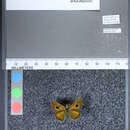pt-BR
nomes no trilho de navegação


Timoconia flammeata, the bright shield-skipper, is a butterfly of the family Hesperiidae. It is found in the Australian Capital Territory, New South Wales, Queensland, South Australia and Victoria.[1][2]
The wingspan is about 30 mm.
The larvae feed on Poa tenera, Tetrarrhena juncea and other Tetrarrhena species. They construct a shelter made of grass stems loosely held together with silk. They rest in this shelter during the day. Pupation takes place in the shelter.
Timoconia flammeata, the bright shield-skipper, is a butterfly of the family Hesperiidae. It is found in the Australian Capital Territory, New South Wales, Queensland, South Australia and Victoria.
The wingspan is about 30 mm.
The larvae feed on Poa tenera, Tetrarrhena juncea and other Tetrarrhena species. They construct a shelter made of grass stems loosely held together with silk. They rest in this shelter during the day. Pupation takes place in the shelter.
Signeta flammeata is een vlinder uit de familie van de dikkopjes (Hesperiidae).[1] De wetenschappelijke naam van de soort is voor het eerst geldig gepubliceerd in 1882 door Arthur Gardiner Butler.
Bronnen, noten en/of referentiesSigneta flammeata là một loài bướm ngày thuộc họ Hesperiidae. Nó được tìm thấy ở the Lãnh thổ Thủ đô Úc, New South Wales, Queensland, Nam Úc và Victoria.
Sải cánh dài khoảng 30 mm.
Ấu trùng ăn Poa tenera, Tetrarrhena juncea và other Tetrarrhena species. They construct a shelter made of grass stems loosely held together with silk. They rest in this shelter during the day. Pupation takes place in the shelter.
Phương tiện liên quan tới Signeta flammeata tại Wikimedia Commons
Signeta flammeata là một loài bướm ngày thuộc họ Hesperiidae. Nó được tìm thấy ở the Lãnh thổ Thủ đô Úc, New South Wales, Queensland, Nam Úc và Victoria.
Sải cánh dài khoảng 30 mm.
Ấu trùng ăn Poa tenera, Tetrarrhena juncea và other Tetrarrhena species. They construct a shelter made of grass stems loosely held together with silk. They rest in this shelter during the day. Pupation takes place in the shelter.